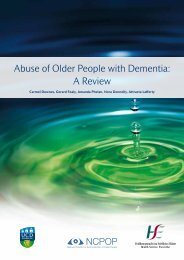Public Perceptions of Older People A literature review
Review 1 PP OP.pdf - National Centre for the Protection of Older ...
Review 1 PP OP.pdf - National Centre for the Protection of Older ...
Create successful ePaper yourself
Turn your PDF publications into a flip-book with our unique Google optimized e-Paper software.
this is referred to as the ‘double standard <strong>of</strong> ageing’ (Sontag 1979). However,<br />
Narayan (2008) asserted that there has been little research that specifically<br />
addresses this issue. Consistent with the ‘double standard <strong>of</strong> ageing’, sketches<br />
<strong>of</strong> older women have been found to be much more likely to include wrinkles<br />
than in drawings <strong>of</strong> older men (Falchikov 1990). However, physical aids were<br />
depicted significantly less frequently in sketches <strong>of</strong> women than men (Barrett<br />
& Cantwell 2007).<br />
The age at which men and women are considered old may be a factor. For<br />
example, Musaiger and D’Souza (2009) found that men were generally<br />
perceived to reach old age at a later age than women. More specifically,<br />
participants in this study viewed 40-49 years as elderly for women, however<br />
70-79 years was considered elderly for men. Researchers have reported that<br />
older males are perceived more favourably than older females, who tend to be<br />
subjected to more negative biases and prejudices (McConatha et al. 2004;<br />
Tan et al. 2004). This was evident in a study by Middlecamp and Gross (2002)<br />
who observed that children had higher levels <strong>of</strong> prejudice against older<br />
women than older men.<br />
In contrast, some studies have found the opposite to be true where older<br />
women are rated significantly more positively than older men (Laditka et al.<br />
2004; Narayan 2008). Arnold-Cathalifaud et al. (2008) reported that elderly<br />
men were perceived as increasingly more intolerant, suspicious and conflictive<br />
than elderly women. In addition, in terms <strong>of</strong> efficiency, 39% <strong>of</strong> elderly women<br />
were deemed efficient compared to 33% <strong>of</strong> elderly men. Elderly women were<br />
also more positively perceived as outgoing (62%) than men (44%) (Arnold-<br />
Cathalifaud et al. 2008). Drawings <strong>of</strong> women by students were found to be<br />
more likely to depict sketches <strong>of</strong> older women with smiles; depict interaction<br />
with grandchildren; or show engagement in social activities (Lichtenstein et al.<br />
2005; Barrett & Cantwell 2007; Barrett & Pai 2008). In some cases, this has<br />
been attributed to cultural representations and expectations regarding gender,<br />
as well as ageing. Specifically, there is greater tolerance <strong>of</strong> emotional<br />
expression among women than men, and women <strong>of</strong> all ages are considered to<br />
be more easy-going, accommodative, kind, and forgiving than men (Barrett &<br />
Pai 2008).<br />
Despite the fact that women tend to live longer than men (Austad 2006), men<br />
have been found to be over-represented in drawings relative to their<br />
23









